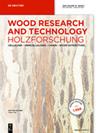Comparative investigation of chemical and structural properties of charred fir wood samples by Raman and FTIR spectroscopy as well as X-ray-micro-CT technology
IF 1.6
3区 农林科学
Q2 FORESTRY
引用次数: 0
Abstract
Abstract Wood surface charring is a treatment method commonly employed to enhance weather protection and aesthetic appearance of building exteriors. This study aims to investigate the differences between two wood surface charring processes: the traditional Japanese method known as Yakisugi and an alternative charring technique industrially manufactured with a gas burner. The objective of the study was to assess whether a thicker layer after Yakisugi treatment has any advantages over a thinner layer after the alternative process. Vibrational spectroscopy techniques including UV resonance Raman (UVRR) and Fourier transform infrared (FTIR) spectroscopy, were utilized in conjunction with X-ray-micro-CT analysis. The findings revealed that ATR-FTIR spectroscopy detected the degradation of carbohydrates and changes in lignin within the charred surface, although both processes exhibited similar vibrational contributions. In contrast, UVRR spectroscopy provided insights into the carbonized layers, revealing spectral differences indicating variations in temperature during the charring processes. X-ray micro-CT analysis visually highlighted significant differences in the coal layers, suggesting distinct combustion profiles. Remarkably, the macrostructure of wood treated with Yakisugi remained intact despite a thicker charred layer compared to the alternative charring techniques. However, further investigations are required to assess the weather stability of the alternative charring method for a comprehensive understanding.利用拉曼光谱和傅里叶红外光谱以及x射线显微ct技术对炭化杉木样品的化学和结构特性进行了对比研究
摘要木材表面炭化是提高建筑外观耐候性和美观性的常用处理方法。本研究旨在研究两种木材表面炭化工艺之间的差异:日本传统的Yakisugi方法和工业上使用燃气燃烧器制造的替代炭化技术。该研究的目的是评估Yakisugi处理后的较厚层是否比替代工艺后的较薄层有任何优势。振动光谱技术,包括紫外共振拉曼(UVRR)和傅里叶变换红外(FTIR)光谱,与X射线微CT分析结合使用。研究结果表明,ATR-FTIR光谱检测到烧焦表面内碳水化合物的降解和木质素的变化,尽管这两个过程都表现出相似的振动贡献。相比之下,UVRR光谱提供了对碳化层的深入了解,揭示了表明碳化过程中温度变化的光谱差异。X射线显微CT分析直观地突出了煤层的显著差异,表明了不同的燃烧剖面。值得注意的是,与其他炭化技术相比,尽管烧焦层更厚,但用烧木处理的木材的宏观结构仍然完好无损。然而,为了全面了解替代炭化方法的天气稳定性,还需要进行进一步的调查。
本文章由计算机程序翻译,如有差异,请以英文原文为准。
求助全文
约1分钟内获得全文
求助全文
来源期刊

Holzforschung
工程技术-材料科学:纸与木材
CiteScore
4.60
自引率
4.20%
发文量
83
审稿时长
3.3 months
期刊介绍:
Holzforschung is an international scholarly journal that publishes cutting-edge research on the biology, chemistry, physics and technology of wood and wood components. High quality papers about biotechnology and tree genetics are also welcome. Rated year after year as one of the top scientific journals in the category of Pulp and Paper (ISI Journal Citation Index), Holzforschung represents innovative, high quality basic and applied research. The German title reflects the journal''s origins in a long scientific tradition, but all articles are published in English to stimulate and promote cooperation between experts all over the world. Ahead-of-print publishing ensures fastest possible knowledge transfer.
 求助内容:
求助内容: 应助结果提醒方式:
应助结果提醒方式:


